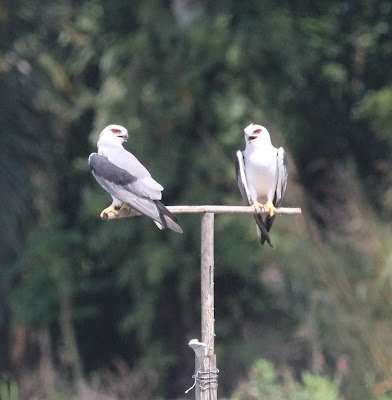On the way to Ulu Dedap ricefields, we stopped by at a place called Chui Chak. Chui Chak is a small town with a population close to about 5000 villagers who are mainly farmers. After a short pit stop for breakfast, we went around the padi fields to look for EMHs.....
We did saw a few EMHs at Chui Chak but majority of them were located quite a distance from us. To id and photo-document them from a distance was quite a task.
Here is an EMH doing its acrobatic dive. When it spots a prey below, this was the most common flight pattern observed.
An EMH about to land. Although they roost and breed on the ground, they do occasional land to take a break - it could be due to the insufficient thermal to lift their wings or maybe to conserve some energy. The numbers of EMHs observed here are few and this is probably not the main roosting area for them. We expect more EMHs at Ulu Dedap - our main survey site !!
While heading to our sheltering site, we did some birding as well. Here are some of the interesting birds seen at this location:
A pocket of Cattle Egrets (i think it is safe to call them "Bubulcus ibis" at the mo).
A lone Common Myna perched on a man-made bird house. I noticed that it is made of fiberglass material !Locals informed us that they have erected these houses to attract birds of prey namely owls or more precisely barn owls to hunt for rodents. That was certaintly a great idea for biological pest control!
At our shelter which was just a small tree, we saw a group of fishes. Although the water looks clear but we are not sure whether it is safe for drinking.
This is a genus of a common snake head family - locals call it "haruan".
This bird has many names - "Black Headed Munia" and "Chestnut Munia" are the most common ones given.
We also saw a lone Yellow Wagtail.
....as well as a bunch of waders - here you could see a Plover.
This Large-Billed Crow also pretended like a harrier
We saw plenty of this White Throated Kingfisher.
This is a resident Black Shouldered Kite. Now is called a Black-Winged Kite, i was informed. Very common in open areas.
The tree where we were sheltering was actually its nesting site and it continued to circle around the tree several times.
After circling awhile, they decided to perch nearby to observe us. In this picture they are not calling but were actually panting ! Yes it was quite hot in the paddy fields although it was just around 11.00am.
This is a Brown Shrike basking in the hot sun.
While searching the skies for raptors we were entertained by these two juvenile Brahminy Kites
They seem like trying to mock at each other.
Out of no where Yang Chong suddenly called out Imperial !!
It circle a few times from a distance but luckily it flew quite close above us.
A majestic fly past !
These are my best shots of the Imperial Eagle ! Although it looks close here but it was actually gliding quite high up in the sky.
This majestic eagle was certaintly a lifer for me although the team also saw not one but three greater spotted eagles from a distance through their scopes.































































